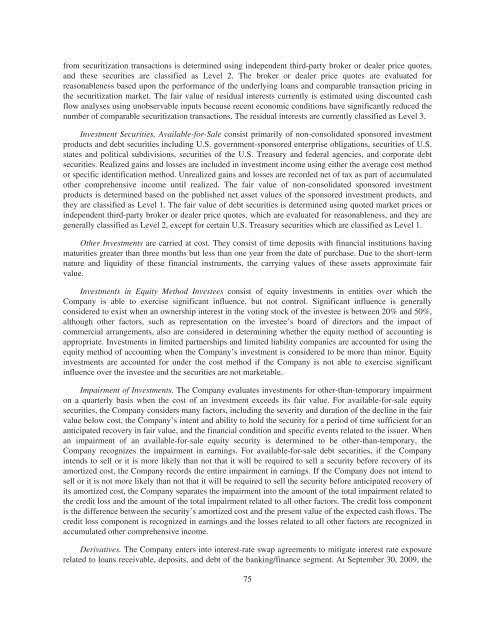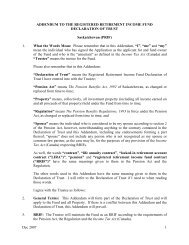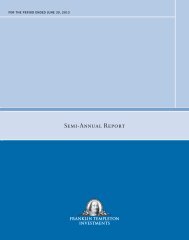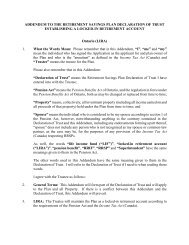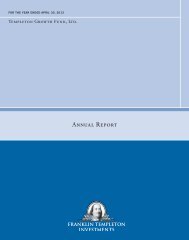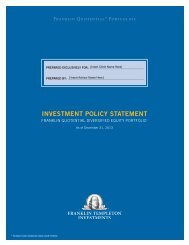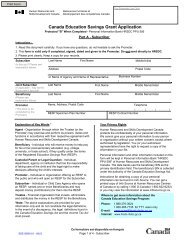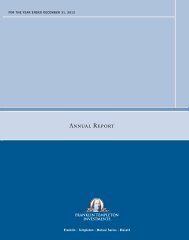PDF Version
PDF Version
PDF Version
You also want an ePaper? Increase the reach of your titles
YUMPU automatically turns print PDFs into web optimized ePapers that Google loves.
from securitization transactions is determined using independent third-party broker or dealer price quotes,and these securities are classified as Level 2. The broker or dealer price quotes are evaluated forreasonableness based upon the performance of the underlying loans and comparable transaction pricing inthe securitization market. The fair value of residual interests currently is estimated using discounted cashflow analyses using unobservable inputs because recent economic conditions have significantly reduced thenumber of comparable securitization transactions. The residual interests are currently classified as Level 3.Investment Securities, Available-for-Sale consist primarily of non-consolidated sponsored investmentproducts and debt securities including U.S. government-sponsored enterprise obligations, securities of U.S.states and political subdivisions, securities of the U.S. Treasury and federal agencies, and corporate debtsecurities. Realized gains and losses are included in investment income using either the average cost methodor specific identification method. Unrealized gains and losses are recorded net of tax as part of accumulatedother comprehensive income until realized. The fair value of non-consolidated sponsored investmentproducts is determined based on the published net asset values of the sponsored investment products, andthey are classified as Level 1. The fair value of debt securities is determined using quoted market prices orindependent third-party broker or dealer price quotes, which are evaluated for reasonableness, and they aregenerally classified as Level 2, except for certain U.S. Treasury securities which are classified as Level 1.Other Investments are carried at cost. They consist of time deposits with financial institutions havingmaturities greater than three months but less than one year from the date of purchase. Due to the short-termnature and liquidity of these financial instruments, the carrying values of these assets approximate fairvalue.Investments in Equity Method Investees consist of equity investments in entities over which theCompany is able to exercise significant influence, but not control. Significant influence is generallyconsidered to exist when an ownership interest in the voting stock of the investee is between 20% and 50%,although other factors, such as representation on the investee’s board of directors and the impact ofcommercial arrangements, also are considered in determining whether the equity method of accounting isappropriate. Investments in limited partnerships and limited liability companies are accounted for using theequity method of accounting when the Company’s investment is considered to be more than minor. Equityinvestments are accounted for under the cost method if the Company is not able to exercise significantinfluence over the investee and the securities are not marketable.Impairment of Investments. The Company evaluates investments for other-than-temporary impairmenton a quarterly basis when the cost of an investment exceeds its fair value. For available-for-sale equitysecurities, the Company considers many factors, including the severity and duration of the decline in the fairvalue below cost, the Company’s intent and ability to hold the security for a period of time sufficient for ananticipated recovery in fair value, and the financial condition and specific events related to the issuer. Whenan impairment of an available-for-sale equity security is determined to be other-than-temporary, theCompany recognizes the impairment in earnings. For available-for-sale debt securities, if the Companyintends to sell or it is more likely than not that it will be required to sell a security before recovery of itsamortized cost, the Company records the entire impairment in earnings. If the Company does not intend tosell or it is not more likely than not that it will be required to sell the security before anticipated recovery ofits amortized cost, the Company separates the impairment into the amount of the total impairment related tothe credit loss and the amount of the total impairment related to all other factors. The credit loss componentis the difference between the security’s amortized cost and the present value of the expected cash flows. Thecredit loss component is recognized in earnings and the losses related to all other factors are recognized inaccumulated other comprehensive income.Derivatives. The Company enters into interest-rate swap agreements to mitigate interest rate exposurerelated to loans receivable, deposits, and debt of the banking/finance segment. At September 30, 2009, the75


